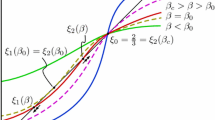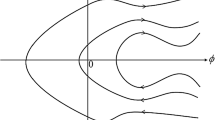Abstract
Nematodynamics is the orientation dynamics of flowless liquid-crystals. We show how Euler-Poincaré reduction produces a unifying framework for various theories, including Ericksen-Leslie, Luhiller-Rey, and Eringen’s micropolar theory. In particular, we show that these theories are all compatible with each other and some of them allow for more general configurations involving a non vanishing disclination density. All results are also extended to flowing liquid crystals.
Similar content being viewed by others
References
Chandrasekhar, S.: Liquid Crystals. Cambridge University Press, Cambridge (1992)
de Gennes, P.G.: Short range order effects in the isotropic phase of nematics and cholesterics. Mol. Cryst. Liq. Cryst. 12, 193–214 (1971)
Doi, M., Edwards, S.F.: The Theory of Polymer Dynamics. Oxford University Press, London (1988)
Dzyaloshinskii, I.E., Volovick, G.E.: Poisson brackets in condensed matter systems. Ann. Phys. 125, 67–97 (1980)
Ellis, D.C.P., Gay-Balmaz, F., Holm, D.D., Putkaradze, V., Ratiu, T.S.: Symmetry reduced dynamics of charged molecular strands. Arch. Ration. Mech. Anal. 197(3), 811–902 (2010)
Eringen, A.C.: An assessment of director and micropolar theories of liquid crystals. Int. J. Eng. Sci. 31, 605–616 (1993)
Eringen, A.C.: A unified continuum theory of liquid crystals. Ari 50(4), 73–84 (1997)
Gay-Balmaz, F., Ratiu, T.S.: The geometric structure of complex fluids. Adv. Appl. Math. 42(2), 176–275 (2009)
Gay-Balmaz, F., Tronci, C.: Reduction theory for symmetry breaking with applications to nematic systems. Physica D 239(20–22), 1929–1947 (2010)
Gay-Balmaz, F., Tronci, C.: The helicity and vorticity of liquid-crystal flows. Proc. R. Soc. Lond. A 467, 1197–1213 (2011)
Gay-Balmaz, F., Holm, D.D., Ratiu, T.S.: Variational principles for spin systems and the Kirchhoff rod. J. Geom. Mech. 1(4), 417–444 (2009)
Gay-Balmaz, F., Ratiu, T.S., Tronci, C.: Equivalent theories of liquid crystal dynamics (2011). ar**v:1102.2918
Holm, D.D.: Euler-Poincaré dynamics of perfect complex fluids. In: Holmes, P., Newton, P., Weinstein, A. (eds.) Geometry, Dynamics and Mechanics: 60th Birthday Volume for J.E. Marsden. Springer, Berlin (2002)
Holm, D.D., Kupershmidt, B.A.: The analogy between spin glasses and Yang-Mills fluids. J. Math. Phys. 29, 21–30 (1988)
Holm, D.D., Marsden, J.E., Ratiu, T.S.: The Euler-Poincaré equations and semidirect products with applications to continuum theories. Adv. Math. 137, 1–81 (1998)
Kleman, M., Lavrentovich, O.D.: Soft Matter Physics—An Introduction. Springer, Berlin (2003)
Krishnaprasad, P.S., Marsden, J.E.: Hamiltonian structure and stability for rigid bodies with flexible attachments. Arch. Ration. Mech. Anal. 98, 71–93 (1987)
Leslie, F.M.: Theory of flow phenomena in liquid crystals. In: Brown, G.H. (ed.) Advances in Liquid Crystals, vol. 4, p. 181. Academic Press, New York (1979)
Lhuillier, D., Rey, A.D.: Nematic liquid crystals and ordered micropolar fluids. J. Non-Newton. Fluid Mech. 120, 169–174 (2004)
Marsden, J.E., Ratiu, T.S.: Introduction to Mechanics and Symmetry, 2nd edn. Springer, Berlin (2004)
Marsden, J.E., Misiołek, G., Ortega, J.-P., Perlmutter, M., Ratiu, T.S.: Hamiltonian Reduction by Stages. Lecture Notes in Math., vol. 1913. Springer, Berlin (2007)
Rey, A.D., Denn, M.M.: Dynamical phenomena in liquid-crystalline materials. Annu. Rev. Fluid Mech. 34, 233–266 (2002)
Volovik, G.E., Kats, E.I.: Nonlinear hydrodynamics of liquid crystals. Sov. Phys. JETP 54(1), 122–126 (1981)
Acknowledgements
Stimulating conversations with David Chillingworth, Giovanni De Matteis, and Giuseppe Gaeta are greatly acknowledged. Also, the authors wish to warmly thank the referees for their valuable comments and keen remarks that helped improving this paper.
TSR was partially supported by Swiss NSF grant 200020-126630 and by the government grant of the Russian Federation for support of research projects implemented by leading scientists, Lomonosov Moscow State University under the agreement No. 11.G34.31.0054.
Author information
Authors and Affiliations
Corresponding author
Appendix: The Free Energy
Appendix: The Free Energy
We reproduce here the computation in [12] that shows how all terms in the Frank energy

can be rewritten in terms of the variables j=J(I−n⊗n) and γ, the latter being introduced through the invariant relation ∇n=n×γ. Thus, the explicit expression for the micropolar free energy Ψ(j,γ) of nematic media given in (4.4) will be written after computing the micropolar expression for each term in the Frank energy. Further details are given in [12].
Twist
Using n⊗n=I−j/J, we have
where γ(n)=γ ia n a , with a being the \(\mathfrak{so}(3)\simeq\Bbb{R}^{3}\)-index, and γ S denotes the skew part of γ, i.e., γ S=(γ−γ T)/2, where we see γ as a 3×3 matrix with components γ ia .
Splay
We introduce the vector \({\vec{{\boldsymbol {\gamma }}} }_{b}=\epsilon_{abc}{\boldsymbol {\gamma }}_{ac}\), defined by the condition \(\vec{\boldsymbol{\gamma }} \cdot\mathbf{u}=\operatorname{Tr}(\mathbf{u}\times\boldsymbol{\gamma})\), for all u∈ℝ3, where u×γ is the matrix with components (u×γ) ia =(u×γ i ) a . We compute

where γ A denotes the skew part of γ, i.e., γ A=(γ−γ T)/2 and where we used the equality \(\widehat{\vec{\boldsymbol{\gamma}}} =-2\boldsymbol{\gamma}^{A}\). The latter can be shown by noting that we have the equalities \(\operatorname{Tr}(\widehat{\vec{\boldsymbol{\gamma}}}\hat {\mathbf{u}})=-2\vec{\boldsymbol{\gamma}}\cdot\mathbf{u}=-2\operatorname{Tr}(\boldsymbol{\gamma}\widehat{\mathbf{u}})\) for all u∈ℝ3.
Bend
For all u∈ℝ3, we have

so we get
and therefore
Summing all the terms, we obtain that the Frank free energy is indeed given by the expression for Ψ provided in (4.4).
Rights and permissions
About this article
Cite this article
Gay-Balmaz, F., Ratiu, T.S. & Tronci, C. Euler-Poincaré Approaches to Nematodynamics. Acta Appl Math 120, 127–151 (2012). https://doi.org/10.1007/s10440-012-9719-x
Received:
Accepted:
Published:
Issue Date:
DOI: https://doi.org/10.1007/s10440-012-9719-x




